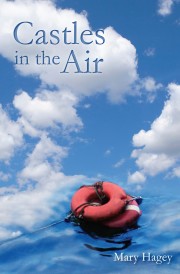Reviews
Fiction Review by Dalyce Joslin
Mary Hagey, Castles in the Air (Winnipeg: Signature, 2012). Paperbound, 221 pp., $19.99.

Mary Hagey’s collection of short stories, Castles in the Air, exposes the bittersweet complexity of family relationships. With overlapping life preservers drifting beside feathery clouds, the cover gestures toward the power of connection and imagination embodied by the characters in the pages that follow. Some characters exemplify kindness, while others exude contempt. Most float between these extremes. Temperaments notwithstanding, these individuals compel attention.
“Home Remedy,” the initial selection, underscores the author’s fascination with mother-daughter relationships. Breast cancer patient Holly McCarthy reluctantly attends a family reunion. Her oncologist recommends “family support” as part of her therapy. An art historian with “not [so] arty” relatives, Holly exhausts her “stockpile of forbearance” for making small talk. Aiming to curb Holly’s increasing rudeness, her mother announces that Holly is writing a novel: a family pretense long embellished since Holly declared her intention at twelve. A cousin presses for details and Holly declares the “phantom” novel to be “essentially a study of family dynamics.” This could be Hagey’s discreet hint to attentive readers about the focus of her collection. As adults Holly and her mother spar as equals, but Holly remains vulnerable to the “force of her mother’s disapproval,” a dynamic Hagey represents with greater force in “The Long Way Home.” Teenage Olivia is driving her parents home after church. During the ride, Olivia’s mother spews unjust criticism: her daughter is too short, her nose too big, and her breasts too small. Olivia responds by driving faster, with tragic consequences. Hagey’s bleak rendering of family dysfunction has the potential to alienate readers, but she moderates the possibility with her judicious choice of point of view. Olivia is presented in a third-person, limited point of view, so that readers can distance themselves from Olivia’s pain, but also monitor her inner wellbeing.
Reminiscent of Holly McCarthy in “Home Remedy,” two additional protagonists convey their experiences in a second-person point of view. In another conspiratorial nod to attentive readers, writing instructor Ray Hanson (“Lifeline”) explains second person to a student. “You put the reader in the character’s skin … you use you instead of I or a character’s name, or he or she.” Having alerted readers to this more unusual point of view, Hagey follows “Lifeline” with two stories written in second person, a choice that places the reader in the action. In “Girls in the Sunlight,” Nigel’s mortification becomes personal as “you … hear the snickering at the mention of your name.” In “How to Cook a Grouse,” Marjorie’s fear of leaving her husband becomes palpable, as “you say no to that old familiar apprehension.” Hagey cleverly has two somewhat self-centered individuals convey their own stories in first-person narration. A lonely older woman (“Modern Women”) manipulates a younger neighbour to gain her friendship. Miriam, an aspiring journalist, (“Human Interest”) exploits her older neighbour to write a humaninterest story. In “Lifeline,” Patrick Dempsey, a charming Irish rogue, is pointedly self-centred. Dempsey captivates his young daughter Anna Marie’s imagination with tales of fairies. He convinces her that “your imagination can take you anywhere. It’s the ultimate getaway.” Shunning the security of a lifeline, Patrick Dempsey drowns at sea. As a mature art student, angered by criticisms from her art instructor and vulnerable to the advances of her writing instructor, Anna Marie imagines her father’s fairies opening the door for her “getaway” and she flees university. Hagey’s poignant, crafted prose both celebrates and mourns the inspirational yet flawed nature of the lifeline Patrick Dempsey has cast his daughter. In “Castles in the Air,” Phil, unemployed and subject to his wife Vera’s endless derision, fights disillusionment by acquiring a part-time job delivering flyers, a job he values for its opportunities to help people and enjoy the affections of their pets. On a visit to his mother, Phil daydreams of childhood summers spent playing in their willow tree. Vera reprimands Phil for daydreaming and ridicules his plans for new employment: an animal bed and breakfast. For Vera, Phil’s dreams are “castles in the air.” For Phil, they are “small gestures” that keep him from “losing his mind.”
Hagey’s strength as a writer extends beyond piercing insights into family dynamics. Amid dark content, delicate details weave the stories together, inviting richer understandings through astute observations. In “Human Interest,” eighty-seven-year-old Gertie Bond is “known throughout the neighbourhood both affectionately and disparagingly as the pigeon lady.” Her best friend, a pigeon she named Ralph, spends his day on her windowsill. Gertie believes pigeons are like humans. “There are bossy ones, timid ones, sneaky ones, and cock-of-the-walk types…and then there’s Ralph, dependable, steadfast and true.” Gertie’s attentiveness to pigeon behaviour reflects the imperfections of human behaviour. Ralph, in turn, signals the more sensitive characters’ kinship with these feathery, airborne creatures. Echoing Gertie’s affection for Ralph, Phil talks to the sparrow outside his window. He watches the sparrow take flight and, when opportunity presents, takes flight into his imagination. Although his callous wife appears to triumph, it is Phil’s inherent humanity and enduring imagination that will inspire readers, testament to the power of Hagey’s writing. As Holly McCarthy concludes, after a day spent with relatives, “like most people you dread your family even under the best of circumstances,” and family relationships are indeed a “tainted elixir.”
—Dalyce Joslin









